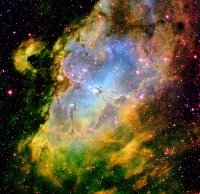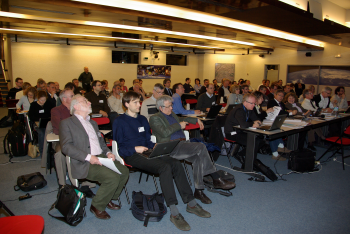
In fact, the response rates from the French science community to this programme was very high. This review was to prepare the French teams to the final competition for selection in the best possible way.
Recall of facts: for the first call for proposals in 2007, fifty missions were proposed among which 22 were leaded by French scientists. Six missions were selected in the first selection phase for feasibility studies. In mid-February 2010, the Scientific Programme Committee (SPC) of ESA selected three medium-class missions within the frame of the Cosmic Vision programme:
- Euclid to study the dark Universe;
- PLAnetary Transits and Oscillations (PLATO) to study the exoplanets;
- Solar Orbiter to study the Sun.
Those three missions thus entered the definition phase. For Euclid and PLATO, ESA should be calling laboratories for tenders around June for providing the payload.

But the selection won't be finished: mid-May, ESA will select two of these missions with targeted launches of 2017 and 2018 at the earliest. The definition phase is supposed to detect the last technical difficulties and make sure that the missions can enter in the available budget.
- Euclid will be focusing on fundamental physics and cosmology questions: nature of the dark matter and dark energy. It will map the galaxy distribution to make the "dark" architecture underlying the Universe appear. Euclid emerged from two proposals, one French, DUNE, which was the subject of a Phase 0 at CNES.
- PLATO will be focusing on one of the oldest science question: the presence of planets around other stars and their hosting capability. PLATO should be able to detect Earth-like telluric planets located in the habitability area of their host stars. PLATO will also study the inside of the stars detecting the gaseous ripples which spread on their surfaces. Here again the French science community is present because a French man could be selected as Principal Investigator (PI).
- Solar Orbiter will brush against the Sun at a distance of only 62 solar radius. It will study the Sun's polar regions and take pictures of the side which is not visible from Earth. The Solar Orbiter's payload features 10 instruments among which 6 with French participation.
The two medium-class missions will be part of the next scheduling phase of ESA (2015-2025) with at least one large-class mission which will be selected in 2012 between three missions:
- EJSM: study of Jupiter and its satellites;
- IXO: an X-ray astrophysics observatory mission;
- LISA: detect and observe gravitational waves.
During this first call for proposals, ESA also offered the European science community the possibility to participate to foreign missions. A proposal to carry the SAFARI instrument, aimed to study the formation conditions of galaxies and planetary systems, on board SPICA, a JAXA's satellite (Japan), was selected for this study. The final decision for SPICA by JAXA and the SAFARI instrument is to be taken in late 2011. This IR telescope should cover the missing spectrum of the Webb telescope (ESA/NASA) and the ALMA ground telescope.